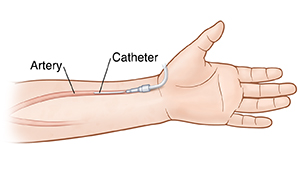An arterial line is a thin, flexible tube (catheter) put into an artery. It's also called an art line. An arterial line makes it easy to check your blood pressure and draw blood samples.
Why is arterial line placement needed?
With an arterial line, your blood pressure can be monitored at all times, such as during an infection or during and after surgery. This lets your health care provider know right away if your blood pressure quickly rises or drops. A standard blood pressure cuff may take too long and may not be exact enough when precise blood pressure measurements are needed.
The line also lets your provider easily take many blood samples for testing. There is no need to stick you with a needle each time. An arterial line also lets your provider take frequent blood gas measurements to know how well your blood is being oxygenated.
Placing the line
Placing the line takes at least 15 minutes but sometimes may take longer, especially in children or elderly adults. A small, short catheter is used. It is most often placed in the radial artery, which is in the wrist area. Other sites that may be used are the arm, foot, or groin.
To place the line:
-
Blood flow through side branching arteries will be checked. This is done to make sure the arterial line will not block blood flow.
-
The insertion site is cleaned with an antiseptic solution.
-
Medicine (local anesthesia) is injected in your skin near the insertion site. This numbs the area so you don't feel pain.
-
A needle is inserted through your skin into the artery. The needle is used to guide the catheter into the artery. After the catheter is in place, the needle is removed. The line is then taped or stitched (sutured) to your skin. This helps keep the catheter from being pulled out.
-
The site is covered with a clear, adhesive bandage.
-
The line is hooked up to a slow, continuous flow of fluid (saline). This keeps it flushed and stops blood clots from forming inside the arterial line.
-
The arterial line will also be hooked up to a monitor. Your care team can check the readings on the monitor.
After the procedure
A health care provider will monitor that the line is working correctly. The line will stay in place for as long as needed. In some cases, the line may be replaced after a certain number of days. Your activity may be limited at the site where the arterial line was placed. This helps stop the line from twisting or blocking the artery site. So if the arterial line is in your wrist, your wrist will be kept straight by using an arm board for support to prevent the flexing of your wrist. If the line is in your groin, you will have to stay in bed. You can’t lift the head of the bed too high. If you do, the tubing and artery may become blocked. The nurses will check your arterial line often for signs of good blood flow. This is to make sure there are no problems.
Tell your provider right away if you have any signs or symptoms of a blocked artery, such as:
-
Severe pain in your body below the arterial line.
-
Cold feeling in an arm or leg below the arterial line.
-
Unusual numbness or tingling in an arm or leg below the arterial line.
Risks and possible problems
All procedures have some risk. Possible risks of placing an arterial line include:
-
Pain.
-
Bleeding.
-
Infection.
-
Blood clots or air bubbles in the artery. This can block blood flow to your heart, brain, or other areas of your body.
-
Blocked catheter, or the line falling out.
-
Sudden narrowing of the artery.
-
A collection of blood (hematoma) at the insertion site.
-
Damage to nerves or the artery.



